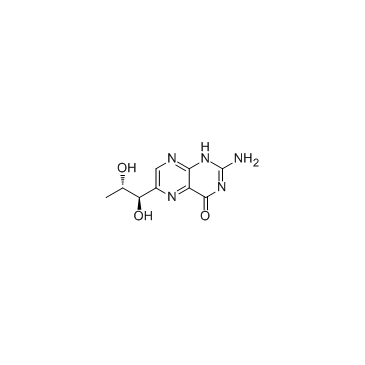6-Biopterin

6-Biopterin structure
|
Common Name | 6-Biopterin | ||
|---|---|---|---|---|
| CAS Number | 22150-76-1 | Molecular Weight | 237.215 | |
| Density | 1.9±0.1 g/cm3 | Boiling Point | 563.4±60.0 °C at 760 mmHg | |
| Molecular Formula | C9H11N5O3 | Melting Point | >210°C dec. | |
| MSDS | Chinese USA | Flash Point | 294.5±32.9 °C | |
| Symbol |

GHS07 |
Signal Word | Warning | |
|
Circulating tetrahydrobiopterin as a novel biomarker for abdominal aortic aneurysm.
Am. J. Physiol. Heart Circ. Physiol. 307(11) , H1559-64, (2014) Rupture of abdominal aortic aneurysm (AAA) is unpredictable and lethal. A clinically valid biomarker to monitor the disease has not been available. Based on our recent discoveries that uncoupled endothelial nitric oxide synthase (eNOS)/tetrahydrobiopterin def... |
|
|
Phenylalanine hydroxylase: function, structure, and regulation.
IUBMB Life 65(4) , 341-9, (2013) Mammalian phenylalanine hydroxylase (PAH) catalyzes the rate-limiting step in the phenylalanine catabolism, consuming about 75% of the phenylalanine input from the diet and protein catabolism under physiological conditions. In humans, mutations in the PAH gen... |
|
|
Communication between the zinc and tetrahydrobiopterin binding sites in nitric oxide synthase.
Biochemistry 53(25) , 4216-23, (2014) The nitric oxide synthase (NOS) dimer is stabilized by a Zn(2+) ion coordinated to four symmetry-related Cys residues exactly along the dimer 2-fold axis. Each of the two essential tetrahydrobiopterin (H4B) molecules in the dimer interacts directly with the h... |
|
|
Normalization of urinary pteridines by urine specific gravity for early cancer detection.
Clin. Chim. Acta 435 , 42-7, (2014) Urinary biomarkers, such as pteridines, require normalization with respect to an individual's hydration status and time since last urination. Conventional creatinine-based corrections are affected by a multitude of patient factors whereas urine specific gravi... |
|
|
Structures and reaction mechanisms of GTP cyclohydrolases.
IUBMB Life 65(4) , 310-22, (2013) GTP cyclohydrolases generate the first committed intermediates for the biosynthesis of certain vitamins/cofactors (folic acid, riboflavin, deazaflavin, and tetrahydrobiopterin), deazapurine antibiotics, some t-RNA bases (queuosine, archaeosine), and the phyto... |
|
|
Tetrahydrobiopterin biosynthesis as an off-target of sulfa drugs.
Science 340(6135) , 987-91, (2013) The introduction of sulfa drugs for the chemotherapy of bacterial infections in 1935 revolutionized medicine. Although their mechanism of action is understood, the molecular bases for most of their side effects remain obscure. Here, we report that sulfamethox... |
|
|
Tetrahydrobiopterin deficiency induces gastroparesis in newborn mice.
Am. J. Physiol. Gastrointest. Liver Physiol. 305(1) , G47-57, (2013) Pyloric stenosis, the most common infant gastrointestinal disease, has no known etiology and clinically presents as abnormal gastric emptying with evidence of pyloric muscle hypertrophy. Whether abnormalities in gastric muscle contraction and/or relaxation ha... |
|
|
Uncoupling of eNOS contributes to redox-sensitive leukocyte recruitment and microvascular leakage elicited by methylglyoxal.
Biochem. Pharmacol. 86(12) , 1762-74, (2013) Elevated levels of the glycolysis metabolite methylglyoxal (MG) have been implicated in impaired leukocyte-endothelial interactions and vascular complications in diabetes, putative mechanisms of which remain elusive. Uncoupling of endothelial nitric oxide syn... |
|
|
Mechanisms of vascular dysfunction in mice with endothelium-specific deletion of the PPAR-δ gene.
Am. J. Physiol. Heart Circ. Physiol. 306(7) , H1001-10, (2014) Peroxisome proliferator-activated receptor (PPAR)-δ is a nuclear hormone receptor that is mainly involved in lipid metabolism. Recent studies have suggested that PPAR-δ agonists exert vascular protective effects. The present study was designed to characterize... |
|
|
Cell type-specific recycling of tetrahydrobiopterin by dihydrofolate reductase explains differential effects of 7,8-dihydrobiopterin on endothelial nitric oxide synthase uncoupling.
Biochem. Pharmacol. 90(3) , 246-53, (2014) (6R)-5,6,7,8-Tetrahydro-L-biopterin (BH4) availability regulates nitric oxide and superoxide formation by endothelial nitric oxide synthase (eNOS). At low BH4 or low BH4 to 7,8-dihydrobiopterin (BH2) ratios the enzyme becomes uncoupled and generates superoxid... |